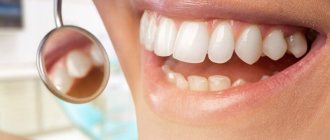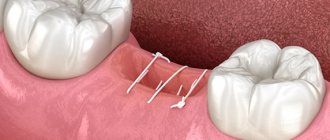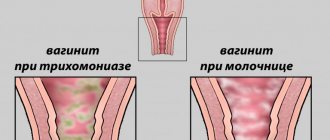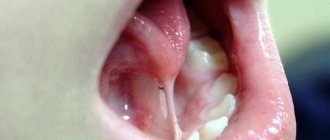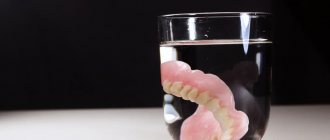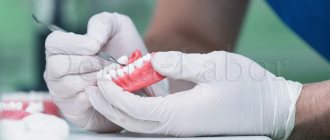Chief editor of the site:
Snitkovsky Arkady Alexandrovich
Chief physician of the professorial dentistry “22 Century”, dentist, orthopedic dentist
Author of the article:
Scientific team of dentistry “22 Century”
Dentists, candidates and doctors of medical sciences, professors
Gingivoplasty involves the removal or formation of gum tissue
For a beautiful and even smile, not only well-groomed teeth are important: healthy gums play an equally significant role. Unfortunately, complaints about the condition of the gums are very common .
One of the most common and aesthetically unpleasant defects is irregular periodontal contour : receding, lifting or uneven distribution of gums along the dentition. This worsens the appearance of the teeth and can lead to more serious diseases: for example, gum recession until the root is exposed can lead to caries and other disorders.
Gum plastic , or gingivoplasty, which involves the removal or formation of gum tissue, which helps improve their appearance and structural condition, will help to cope with this problem
Indications for gum surgery
Surgical operations on the gums are indicated for pathologies of periodontal tissue caused by congenital anomalies, inflammatory processes or mechanical trauma.
- Gummy smile Exposing mostly the gums rather than the teeth when smiling. It is caused by the gingival tissue covering part of the crowns due to under-eruption of teeth; the teeth appear too short.
- Gum recession and exposure of tooth roots Resorption of soft tissues due to dental trauma, congenital features, long-term orthodontic treatment, excessive plaque accumulation. Teeth look too long.
- Gingival hypertrophy An abnormal growth of gingival tissue associated with genetic pathology or developed against the background of an inflammatory process.
- Inflammation of gum pockets Formation of periodontal pockets, accumulation of dental plaque due to poor hygiene, malocclusion, gum disease.
- Formation of a gingival hood Inflammation of the gums over the unerupted part of the crown of a wisdom tooth due to its difficult growth.
- Short frenulum of the lips or tongue Congenital defects in the development of the fold of mucous membrane connecting the lips to the gums or the tongue to the floor of the mouth.
A separate type of indication is associated with the correction of the gum line before tooth restoration:
- Before prosthetics Required in cases of gum loss, unequal volume in different parts of the jaw, small height of the teeth, the presence of periodontal pockets and detachment of the mucous membrane from the surface of the teeth.
- Before and after installation of implants Surgical correction of the soft tissues of the gums before implantation - in the case of bone grafting, after installation of the implant - in order to form an aesthetic gingival contour.
Methodology
The goal of gum surgery in case of periodontal tissue deficiency is their restoration at the expense of neighboring parts of the oral cavity. When contouring gums, on the contrary, excess gum tissue is removed. The operation is performed by a periodontist surgeon under local or general anesthesia, depending on the patient’s wishes.
Before performing gingivoplasty, it is necessary to heal all carious cavities and remove existing acute inflammatory processes.
During the operation, the doctor makes an incision in the gingival margin as close to the tooth and cleans the root surface of dental deposits, plaque and food debris.
The further course of the operation will depend on the type of plastic surgery: for example, with local recession, incisions are made in the area of the periodontal pocket, resulting in detachment of the flap, which is applied to the exposed area. If the recession is generalized, then fragments of soft tissue are transplanted from the palate. If necessary , procedures aimed at transplanting or restoring bone tissue are performed during the operation.
After all manipulations, the edges of the wound are sutured using a non-absorbable polyamide thread and a temporary bandage is applied to it. Stitches are usually removed after 10-12 days.
Types of gum surgery
The type of plastic surgery is determined by the doctor depending on the indications and condition of the gums, as well as the intended purpose.
Gum augmentation
Methods are used that restore gum volume when it is deficient.
- Vestibuloplasty An operation to deepen the vestibule of the oral cavity by increasing the volume of fixed gums that are too tightly fused with the muscles of the lips, cheeks or tongue. It is used if the tension of the facial muscles during speech communication and the process of chewing chronically injures the attached gum, which leads to its recession, the formation of periodontal pockets and exposure of tooth roots.
- Frenuloplasty The procedure of cutting the frenulum of the lips or tongue. It is used for congenital pathologies of the development of the frenulum, which provoke the appearance of a gap between the front incisors, the formation of gum pockets, excessive accumulation of dental plaque, gum disease, and exposure of tooth roots.
- Application of grafts Surgery to close gum recession by moving donor flaps from other parts of the oral cavity (gums, hard palate). In rare cases, it is possible to use special collagen membranes, which trigger the process of natural regeneration of the damaged area, but this option is not suitable for all patients.
Reducing the volume
An operation is performed - gingivectomy. This is the surgical excision of overgrown gum tissue during hypertrophy.
Helps reduce periodontal pockets, slows down the progression of gum disease if the pathology is caused by an inflammatory process.
After removing excess mucous membrane, an aesthetic gum contour is formed. Elimination of inflammation
Techniques are used aimed at eliminating inflammatory processes.
- Flap surgery is a surgical method for the treatment of moderate and severe periodontitis, aimed at reducing periodontal pockets, removing affected gum tissue and tooth roots, and restoring periodontal disease. During the operation, the gum is cut and peeled off, a flap of mucous membrane is formed, which, after removing the affected structures, is fixed in the desired position. If the flap volume is insufficient, a graft from another part of the oral cavity can be used.
- Excision of the gingival hood Pericoronarotomy is an operation to remove the overhanging inflamed gum over the erupting wisdom tooth. In the case of a purulent form of the disease, the gums are first dissected and anti-inflammatory therapy is carried out. After stopping the acute phase of inflammation, the hood is completely excised.
Only an experienced specialist can choose the most effective method for a specific clinical case, taking into account the type of gum pathology, the causes of development and the characteristics of the patient’s dental system as a whole. This requires certain knowledge, which ordinary dental surgeons who remove teeth do not always possess.
In our Center, gum surgeries of any degree of complexity are performed daily by experienced periodontists or maxillofacial surgeons with over 6 years of experience, deep theoretical knowledge and refined manual skills.
Medvedeva Tatyana Alexandrovna
Dentist-periodontist, 6 years of experience
Specialist in the diagnosis and treatment of gum diseases. Conservative, surgical, regenerative treatment. Microsurgical operations without pain under sedation.
More about the doctor
Attention!
Progressive recession of the gum tissue can lead to tooth loss , as a result of which it will be necessary to replace it with prosthetics, which will cost much more than the cost of gum surgery.
If you need help with issues related to the condition of your gums, contact our dental clinic.
Date of publication: September 20, 2020 Last update: September 22, 2022 © 2020 Professorial Dentistry “22 Century”. All rights reserved.
Preparing for gum surgery
Diagnostics
Any operation is planned based on the results of the examination. In order to choose the right method for gum correction, the periodontist conducts a visual and instrumental examination. Computed tomography allows you to obtain more detailed information about the condition of the jaw structures.
Sanitation of the oral cavity
An important point before surgery is to ensure aseptic conditions in the oral cavity to avoid infection. Therefore, before the operation, sanitation (removal of caries, removal of diseased teeth that cannot be treated) and professional hygiene are required.
Excluding the causes of the disease
If a patient is diagnosed with bite problems, consultation and treatment with an orthodontist may be required, since these pathologies are one of the main causes of gum disease.
If the gingival contour is disrupted due to a traumatic factor with crowns or dentures, it is necessary to replace the orthopedic structures.
Gingivoplasty - what is it?
Gingivoplasty is one of the types of surgical interventions in dentistry. The operation consists of eliminating pathological changes, as well as congenital defects of the gums in order to restore its aesthetic and functional state. To achieve results, the surgeon performs different types of manipulations:
- removal of hyperplastic tissue;
- extension of soft tissue in areas of recession;
- alignment of the gum contour;
- elimination of defects of the frenulum of the lips and tongue.
Gum plastic surgery can be performed using the classical method using a scalpel or using laser technology. The duration of the recovery period is 1-2 weeks.
Operation stages
- Anesthesia Local anesthesia is used, which eliminates pain and discomfort. If the patient wishes, sedation can be used.
- Operation Performed according to the procedure. Gum tissue is excised, augmented or moved, depending on the type of pathology.
- Suturing The operated area is treated with anti-inflammatory drugs, and sutures are placed using the finest threads.
The duration of gingivoplasty depends on the chosen technique, and can range from twenty minutes to several hours. Surgical sutures are removed after 10-14 days.
Surgical treatment of gums should be as gentle as possible
In our Center, all mucogingival operations are performed under the optical magnification of a Seiler dental microscope. Allows the use of special microtools and the finest suture material. This ensures a reduction in rehabilitation time and an impeccable cosmetic effect.
Levin Dmitry Valerievich Chief physician and founder of the Doctor Levin center
Step-by-step description of gingivoplasty
Gingivoplasty is performed on an outpatient basis in a dental operating room by a periodontist surgeon. A mandatory step before surgery is diagnostics, including:
- Gum plastic surgery after implantation
- blood testing (general clinical blood test with leukocyte formula, determination of hemoglobin concentration, coagulogram);
- ELISA for infections (HIV, syphilis, hepatitis);
- orthopantogram;
- ECG;
- consultation with narrow specialists (if necessary).
Before surgery, the patient must visit a dental hygienist and therapist (to sanitize the oral cavity). A few days before surgery, you should not take alcohol or blood thinners.
The surgical protocol depends on the patient's diagnosis. General scheme of gingivoplasty:
- Anesthesia. It is carried out with local anesthetic drugs. General anesthesia is rarely used.
- Disinfection of the surgical field.
- Excision of mucous membranes, formation of a flap.
- Carrying out the intervention in accordance with the chosen technology (flap surgery, gingivectomy, curettage, bone grafting, etc.).
- Treating the wound surface with medications.
- Aligning the edges of the wound, suturing.
A periodontal bandage is fixed over the sutures, which is removed only after 2-3 days. The duration of the manipulation is 1-1.5 hours. On days 5-7 after gingivoplasty, the patient is invited for a follow-up examination. The stitches are removed on the 10th day.
Why is it better to do gingivoplasty “in your sleep”?
If the patient is very afraid and worried about the upcoming operation, we suggest performing it under sedation. This is an immersion into a state of light sleep with the help of safe sleeping pills under the supervision of our experienced anesthesiologist.
Sleep therapy provides:
- Maximum comfort A person does not feel pain or experience emotional stress. Awakening is, as usual, quick and easy.
- High-quality treatment The doctor is 100% focused on the operation, eliminating the possibility of inaccurate actions due to random movements of the patient.
- Risk prevention The patient is not worried, the blood pressure is normal, the risk of bleeding, and therefore the formation of edema and hematomas, is lower.
- Improved healing There is no release of stress hormone, which reduces the immunological status and slows down the regeneration processes.
Laser gingivoplasty
Most plastic surgeries in modern dentistry are performed using laser technologies. Instead of a classic scalpel, the surgeon uses a laser knife. Interventions carried out using this method have a number of advantages:
- Prevent the development of bleeding. The moment of incision is accompanied by simultaneous coagulation of tissues and blood vessels. The maximum blood loss during laser gingivoplasty is about 5 ml.
- Prevents infection from entering the wound. The operation is carried out without contact, so the introduction of pathogenic flora into the incision area is excluded.
- Provide maximum precision in flap excision. The absence of a human factor makes it possible to carry out cuts strictly according to the intended pattern.
- Guaranteed safety. The use of a laser prevents mechanical damage to nearby tissues.
The laser technique is less painful compared to conventional gingivoplasty. Wound healing occurs faster and less time is required for rehabilitation.
Recovery after plastic surgery
Rehabilitation after gingivoplasty takes from 5 to 20 days, depending on the volume of surgical procedures performed and the individual characteristics of the body. In the first 3 days, swelling and soreness of the gums and adjacent areas may normally be observed. Gradually, the unpleasant symptoms will go away on their own.
Accelerated rehabilitation complex
Especially for patients who, due to a busy work schedule, cannot afford to stay at home for several days until postoperative unpleasant symptoms go away on their own, we have developed a unique accelerated rehabilitation program. With its help, recovery is reduced to 1-2 days.
Home care
In the postoperative period, in order to avoid complications, it is important to follow the doctor’s recommendations and strictly follow the instructions:
- Careful oral hygiene (do not touch the wound surface while brushing your teeth)
- Exclusion from the diet of foods that irritate the mucous membrane (spicy, salty, sour, too hot and cold, hard)
- Stop smoking on the first day after surgery, optimally for the entire rehabilitation period (nicotine slows down the regeneration process and increases the risk of complications)
- During the entire rehabilitation period, physical activity, flying, diving, and off-road driving are prohibited.
- Performing oral baths using antiseptic solutions
- Taking antibacterial and other drugs (only as prescribed by a doctor)
Our periodontist selects the medications necessary for recovery individually for each patient.
In case of any suspicious issues (bleeding, enlargement of the operated gum, pain, fever), please do not self-medicate, but contact the clinic. The patient support service is available 24 hours a day.
Advantages and disadvantages of the procedure
Gingivoplasty can solve many gum problems and stop the development of serious diseases. But, despite numerous advantages, the technique also has negative sides.
| Advantages | Flaws |
|
|
What determines the cost of the operation?
The cost of gingivoplasty depends on the chosen method and the extent of surgical intervention.
Any, even the most advanced situation on the gums can be corrected and made better and more beautiful. But in some situations, previously performed procedures complicate the process of rehabilitation with old scars.
All types of gingival margin reconstruction directly depend on the gum biotype. The thicker the gingival contour, the cheaper and simpler the treatment. If the gums are of the ultra-thin biotype, any surgical treatment will be a challenge for the patient and the doctor.
Gingivoplasty after implantation
Formation of gums after implantation of a titanium root is considered a mandatory procedure if its installation was carried out in place of a long-missing tooth. Gum recession in the implant area can lead to its loss or the addition of an infectious process.
To correct gum deficiency, patch technology is used. The autograft can be taken from the palate, cheek, and other areas of the oral mucosa. Gingivoplasty can be performed both during and after implantation.
Photos before and after
Negative dynamics after gingivoplasty are observed in no more than 3% of those operated on. Most cases have a positive prognosis. We offer a selection of photographs taken before and after gingivoplasty.
